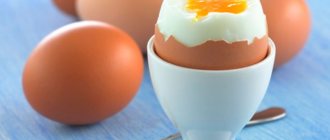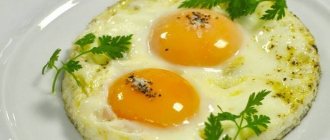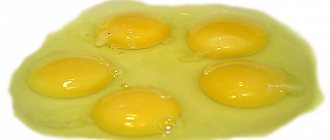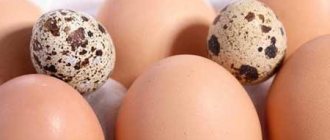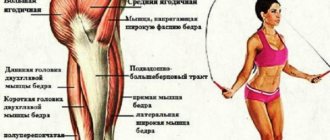Eggs are a frequent guest on many people's tables. They are added to a huge number of dishes and eaten on their own. You can boil and fry eggs in a variety of ways. The eggs of not only birds, but also some species of reptiles, such as turtles, are considered edible. Due to the availability and taste, people prefer to feast on chicken. Quail eggs are consumed much less frequently, and duck, turkey, ostrich or goose eggs are eaten extremely rarely.
The product is common and popular, but also unique. It is absorbed in the human body almost completely (97%). The structure of eggs is such that only one part is the white, and the rest is the yolk. The latter contains proteins, fats, and cholesterol. Protein that turns white during cooking consists of only 10% protein itself, and the rest is water.
Calorie content of eggs
| In a raw chicken egg | 158 kcal per 100 g |
| One medium raw egg | 70 kcal |
| In one boiled egg | 50-70 kcal |
| In a soft-boiled egg | 70 kcal |
| Hard-boiled egg | 50 kcal |
| In one fried egg in vegetable oil | 125 kcal |
| In a quail egg | 16-17 kcal |
| In a raw ostrich egg | 118 kcal per 100 g |
There are about 158 kcal per hundred grams of product. Here it is necessary to take into account that eggs are bought and eaten individually, so you should focus on the size, method of preparation, and type. A medium egg has 70 calories, a large egg has 80 calories, and a very large egg has 90 calories. These indicators are valid only for raw products; during cooking, the energy value changes.
A fried egg already contains 125 kcal. This applies to a product that is fried using vegetable oil. If you boil it soft-boiled, then the calorie content will be less, that is, 70, and hard-boiled - 50 kcal. It should be borne in mind that the protein contains three times less calories than the yolk.
A quail egg is small in size and weight, which varies from 10 to 12 grams. Since it is possible to buy this product, which is becoming quite popular, in almost every supermarket these days, the issue of its energy value becomes relevant. One quail egg contains 16-17 kcal.
What happens if you eat three eggs every day?
Properties
Let's forget for a second about the calorie content of a fried egg in oil and talk about how many eggs you can eat a day to maintain health, without harm. 1-2 pieces are enough!
We also recommend: Cashew
It is better to introduce the product into the diet in the morning or afternoon; in the evening you should avoid such dishes - they take a long time to digest and be absorbed by the body. However, it is permissible to consume it on an empty stomach after drinking half a glass of water or tea.
Benefit
What beneficial properties of eggs can we talk about? The list will be impressive:
- Gives a boost of vigor and energy;
- Improves the condition of hair and nails, increases skin elasticity;
- Normalizes blood sugar levels;
- Protects against anemia;
- Removes toxins and waste;
- Improves metabolism;
- Strengthens the immune system;
- Ensures normal functioning of the nervous system and brain function;
- Stimulates collagen production;
- Reduces calorie consumption and perfectly fills you up;
- Supports vision;
- Increases muscle tone.
Harm
The calorie content of 1 fried egg is low, which allows you to eat the product while on a diet. Everything is clear about the beneficial properties - what about possible harm?
This list is short - which is great. But there is something to talk about:
- Cholesterol. Yolks contain a lot of cholesterol, it is healthy and a person needs it in reasonable quantities. However, when frying, it burns, becomes harmful and negatively affects the figure and condition of blood vessels. There is nothing to worry about if you eat no more than 1-3 eggs;
- Salmonellosis. This is a bacterium that causes acute intestinal infection - you can avoid an unpleasant “meeting” if you subject the product to sufficient heat treatment. Therefore, it is not recommended to eat raw yolks;
- Digestive problems. If you add a lot of oil when frying, you may experience flatulence, heaviness, bloating and other unpleasant consequences. It is better to stop using it if you suffer from gastritis, ulcers, pancreatitis and other gastrointestinal diseases.
You can fix the problem in a simple way - use a small amount of olive oil or avoid it altogether. It is better to serve the dish with fresh vegetables and cheese.
We counted the calories in a fried egg, looked at the beneficial and harmful properties - it's time to discuss cooking methods!
We also recommend: Adyghe salt
Nutritional value of eggs
Determined by the beneficial substances included in the product. Eggs contain minerals required by the human body, as well as amino acids and vitamins. The product owes its nutritional value and value to the following substances:
- active provitamin A;
- vitamin D, the concentration of which is second only to fish oil, which is known for its benefits to humans;
- vitamins E and group B, and, along with B1 and B2, the yolk is rich in choline (B4);
- calcium, iodine, copper, phosphorus, iron;
- cholesterol, which does not pose a threat to health, as it is balanced by lecithin;
- polyunsaturated fats, which, like the cholesterol contained in eggs, do not cause any harm to health.
Thus, it turns out that both cholesterol and fats that enter the body with eggs are absolutely safe. In addition, the product provides a person with approximately 96% of minerals, as well as useful vitamins.
Composition of nutrients, BJU
Scrambled egg, fried egg
| For quantity: 100 grams | ||
| Calories — 196 | Calories from fat - 134 | |
| BJU | ||
| Total fat content | 14.84g | |
| Saturated | 4.32g | |
| Polyunsaturated | 3.25g | |
| Monounsaturated | 6.18g | |
| Cholesterol | 401 mg | |
| Total carbohydrate content | 0.83g | |
| Dietary fiber | 0g | |
| Sugar | 0.4g | |
| Squirrels | 13.61g | |
| Vitamins and microelements | ||
| A - 219 mcg | C - 0mg | |
| B-6 – 0.18 mg | B-12 - 0.97mcg | |
| D - 2.2 µg | E - 1.31 mg | |
| Calcium 62mkg | Iron 1.89 mg | |
| Magnesium 13mg | Zinc 1.39 mg | |
| Potassium 152 mg | Sodium 207 mg | |
Distribution of calories for BJU:Carbohydrates (5%) Fats (68%) Proteins (27%) | ||
Eating eggs on a diet
Every person who wants to gain weight and adheres to a diet is invariably interested in the question of whether this product is compatible with the process of losing weight. In this matter, you should listen to the advice of nutritionists. Many experts recommend eating 2 to 3 eggs per week. On low-carb diets, this amount can be increased.
Including eggs in your diet can help you lose weight and support your immune system. Hard-boiled, they are found in most popular diet programs. Among them are Protasova, Atkins, by blood group, Kremlin and, of course, protein.
How is the product useful?
Eggs contain a whole range of vitamins and beneficial nutrients necessary for the human body to maintain normal functioning, including:
- niacin (necessary for the synthesis of sex hormones and normal blood circulation in the brain);
- choline (responsible for the process of removing poisons from the liver, improves memory);
- vitamin K (takes part in blood clotting processes);
- folic acid (responsible for the correct formation of the neural tube of the fetus, prevents the development of congenital defects in the baby);
- animal protein (without it the formation and regeneration of cells and tissues of the human body is impossible).
In addition, a chicken egg contains vitamin A, vitamin E, B vitamins, and in vitamin D content it is second only to fish oil.
How to choose the right eggs
To answer this question, you need to decide whether regular table eggs or diet eggs will be eaten. The ability to read the labels allows you to distinguish both of these products from each other. On the territory of the Russian Federation, the letter “D” is placed on a dietary egg, the shelf life of which does not exceed a week, but “C” is placed on a table egg, the sale of which is given about 25 days.
The weight of the egg is marked with the second marking symbol in ascending order with the numbers 1, 2 and 3. Selected ones, weighing from 65 to 75 g, have the letter “O” on the shell, premium ones with a weight of more than 75 g - the letter “B”. However, when purchasing a product, be sure to pay close attention to when the egg was “released.” If the product is packaged in a container, it must be opened to check its integrity.
The quality or taste of eggs, as many mistakenly believe, does not depend in any way on color. It ranges from pure white to light brown.
Scrambled eggs, fried eggs in oil in other servings:
196
1.96
| Qty | A portion | Calories | In the counter |
| 100 g | 196 | ||
| 1 g | 1.96 | ||
| 78 | 1 small egg = 40g | 78 | |
| 98 | 1 medium egg = 50g | 98 | |
| 127 | 1 large egg = 65g | 127 | |
| 147 | 1 very large egg = 75g | 147 | |
| 5 | 1 teaspoon = 2.6g | 5 | |
| 16 | 1 tablespoon = 8g | 16 |
Quantitative norm for egg consumption
The average person, if we look at the generally accepted nutritional standard, should consume about three hundred eggs annually. This is approximately from five to six pieces per week. For people suffering from high cholesterol, this amount should be halved.
Yolks are introduced into children's diets at the age of seven months. It is permissible for two- and three-year-old children to be given two to three yolks per week; a similar number of eggs can be consumed from four to six years of age.
Speaking about the number of eggs, you need to remember that they are included in baked goods, mayonnaise and other food products, including homemade ones.
Heat treatment - calorie content of boiled protein and fried protein
It is no secret that the calorie content of a dish largely depends on the method of its preparation.
In order to preserve all the beneficial properties of egg white and at the same time not increase its calorie content, the optimal heat treatment for this product is boiling it. The calorie content of boiled egg white is about 40-44 kilocalories per 100 grams of the finished product.
The calorie content of fried egg whites will be higher due to the fact that additional fats are used during the frying process. And if you fry a whole egg, then the calorie content of the dish reaches 360 kilocalories per 100 grams of product.
Popular egg recipes
The uniqueness of eggs lies in the fact that they can be prepared in completely different ways, which invariably affects both calorie content and taste. Those on a diet are recommended to include this product in their diet exclusively soft-boiled, since it is in this form that eggs have the minimum calorie content.
Eggs are prepared according to the following recipes:
- Boiled soft-boiled and hard-boiled. In the first case, the eggs are boiled from 2 to 3, and in the second - from 7 to 8 minutes.
- Fried. Scrambled eggs are cooked in a frying pan using a small amount of vegetable oil with the addition of salt and ground black pepper. It can be fried on both sides or on one, resulting in a wonderful fried egg. If you shake the eggs well, then ordinary scrambled eggs will turn out to be scrambled.
- Omelette. A light and popular dish made from eggs beaten with milk. It is salted and peppered to taste and then fried in a frying pan. To make the dish tastier, add fresh bell peppers, tomatoes, cheese, and ham. The “stuffing” is selected according to your preferences.
- Poached. These are eggs that are boiled peeled, that is, without shells. This cooking method was invented by the French.
Finding a recipe that suits your taste is not difficult.
How many calories are in protein?
Before answering this question, let’s consider what chicken protein consists of. It turns out that 80% to 85% of egg white is just water. Fat in egg white is no more than 0.5-1% of its composition. Proteins account for 12.5-14%, carbohydrates – up to 1%. It is this composition that explains the low calorie content of egg white.
Protein accounts for up to a quarter of the calories of the total calorie content of the product. As a rule, the white of one egg contains from 15 to 20 kilocalories.
Having a low calorie content, egg white is not without a lot of beneficial properties. It contains B vitamins, enzymes (dipepsidase, protease, diastase) and amino acids necessary to maintain normal functioning of the human body.
